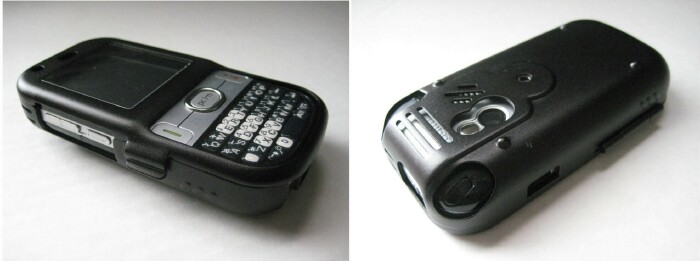
For anyone who migrated from a Treo to the Centro, the smaller size was clearly the main draw. Adding a case to the Centro, especially one of the bulkier hard variety, can seem like two steps forward, one step back — unless, of course, you had a high standard of protection in the first place, and were leaving behind a similarly encased Treo.
In transitioning from making a metal case for the Treo to making one for the Centro, Monaco has made a couple of minor design improvements that amount to slightly more than a mere size reduction. The Centro model has less of the unfinished quality of the MonacoÂ’s Treo versions.
Design and Usability
Like the Treo versions, this case is made from aluminum, with an anodized exterior and a neoprene-lined interior. Black and Silver versions are available. Monaco designed the case to be compatible with SprintÂ’s version of the Centro when it was the only version around. Unfortunately, due to design deviations, the case is not compatible with the AT&T version of the Centro.

ItÂ’s nice to see anodized aluminum used for something more than really cool cookware. It adds a very pleasant visual and tactile texture to the case. Like the soft touch paint on the Foleo, the coating takes some of the coldness away from the metal, making the case almost feel like plastic, but more rigid.
The case is hinged on the right side, and has a grip latch on the left side. Where itÂ’s possible to easily mold plastic cases into two-piece models that snap together without a latch or hinge, itÂ’s apparently more difficult to do with metal versions. The latch and hinge protrude from the bodyÂ’s rounded rectangle contouring, aesthetically detracting from the otherwise graceful profile. They also make the case less pocket-friendly, as they risk catching on your pocket lining or, worse, your fingers.
As mentioned, the Centro version is a step up from MonacoÂ’s various Treo versions. The models for the later antennaless Treos are completely open at the top, as though the phone is meant to slide in from the top, but still has a hinge on the side since the phone actually loads from the front. The cases for the antenna appendaged Treos have a raised inlay on the front over the speaker area. The Centro version looks much more streamlined and integrated.
But one design issue the Centro case shares with the previous cases is some nonfunctional detailing on the back and the sides. ThereÂ’s some grilling on the top left corner, more above the camera cutout (where thereÂ’s no speaker), and a triplet of canted outdents on the sides; all of which are the equivalent of automotive tailfins.
Like all hard cases, the keyboard and application buttons are exposed. Like some hard cases, a window covers the screen area. The top half is raised about 2mm from the rest of the front. I would have liked a completely flush surface, but the raised portion over the screen allows space for neoprene lining where it matters most. If you dropped the Centro, and it landed on its front, the window might crack, but itÂ’s unlikely that any further harm would come to the device itself.
The window has two disadvantages. It smudges easily, though it wipes easily, since itÂ’s flush with the frame (something I wish Palm would do with the screen of the Centro). It also blocks access to the touchscreen, so if youÂ’re a heavy stylus user, this is not the case for you.
As with all Monaco cases, the swivel clip they provide is only serviceable. The bolt screws into the body, rather than using a two-piece assembly that clips over the interior and exterior of the caseÂ’s back. The clip itself is MonacoÂ’s usual choice: a 360-degree non-ratcheting type thatÂ’s unable to lock at angles for wearing horizontally.
The case has a pretty complete set of cutouts, permitting access to everything weÂ’ve come to expect: the Athena connector, the headphone jack, the lanyard pin, the custom button, the volume controls, the status light, the front and back speakers, the mute switch, the camera, and the IR port. The only omission, the most common one in Centro cases, is a cutout for the microSD slot.
Conclusion
The Monaco Aluminum Hard Case naturally adds enough bulk to the Centro to make you feel like youÂ’ve gone back to the Treo. But, of course, a Treo with a hard case would be even bulkier. Anyone in the market for a hard case already knows to expect a compromise in size.
The caseÂ’s aesthetics are a little inelegant in a couple of places, as metal cases tend to be, but the overall look is robust and professional, and the anodized surface has a great feel to it.
More importantly, the Monaco is probably the most protective case currently available for the Centro. It might scuff or dent on a drop, but once you see the Centro inside of it, youÂ’ll be completely confident that the device wonÂ’t shatter.
|
|
| Pros |
Anodized coating gives metal a pleasant look and feel
Interior lined with neoprene to absorb shocks
Rigid but lightweight
Cutouts for everything except microSD slot
|
|
| Cons |
Adds significant bulk to the Centro
Detailing on sides and back rather busy
Protruding lock and hinge not ideal for wearing in pocket |
|